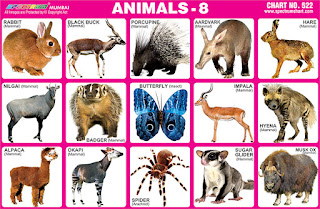Rabbit (Mammal) - Rabbits are small mammals that belong
to group of animals called Lagomorphs. They can be found on all
continents except Antarctica. Rabbits prefer edges of the forests,
but they also inhabit deserts, marshes and grasslands. Rabbits are
vegetarians, they eat leafy plants and bark. Commercially rabbits are
bred for it's meat, fur, wool & for laboratory testing purpose.
Black Buck (Mammal) - Black buck
also known as the Indian antelope, is an antelope found in India.
Black buck inhabits grassy plains and slightly forested areas. Black
Buck have black and white fur. Upper part of the body is black,
while the under part and a ring around the eyes is white in colour.
Black Buck are herbivorous. They prefer eating Grass, fruits, pods,
flowers, shrubs and herbs.
Porcupine (Mammal) - Porcupines
are rodents. They live in America, Africa, Europe and Asia. Body of
the porcupine is covered with sharp spines or quills. Porcupines
can't shoot out their quills, but they will be easily released when
predators get it touch with animal. Porcupines are nocturnal
animals. They are herbivorous animals. They like to eat leaves,
stem, bark, fruit.
Aardvark (Mammal) - Aardvark
is a mammal that resembles many different creatures: it has ears
like rabbit, tongue like anteater, tail like kangaroo, webbed feet
like duck and snout like pig. Aardvark lives in the sub-Saharan
Africa. This is very shy creature that can be seen rarely. Aardvark
is known as an omnivore. Aardvark is nocturnal and solitary animal.
Hare (Mammal) - Hare, also
known as jackrabbit, is small mammal that belongs to the family
Leporidae. Hare has furry coat that can be white, yellowish-brown,
brown or black-coloured and usually covered with dark markings. Hare
is a herbivore. Its diet is based on the grass, fern, seed and
vegetables.
Nilgai (Mammal) - Nilgai is
the large antelope that is native to Asia. Nilgai is large animal.
It usually has 4 to 5 feet in height, 6 to 6.6 feet in length,
weighing up to 530 pounds. Nilgai is herbivorous animal. They eat
grass, leaves, buds and fruits. They can survive long periods
without water. Nilgai lives 12 to 13 years in the wild and up to 21
years in captivity.
Badger (Mammal) - Badger
is small mammal that belongs to the weasel family. Badger is covered
with grey, coarse coat. It has black face with white markings, light
stripe on dorsal side of the body, light-coloured belly and
dark-coloured legs. Badger has elongated head, small ears, stocky,
wedge-shaped body, short legs and broad feet equipped with long
claws.
Butterfly (Insect) –
Butterfly is a
day-flying insect of the order Lepidoptera. Butterflies have three
main body parts. These parts are the head, the thorax and the
abdomen. Butterfly has four wings covered with tiny scales. When a
butterfly is not flying, its wings are usually folded over its back.
The wings are patterned and are often brightly coloured.
Impala (Mammal) - Impala
is a type of antelope that can be found only in Africa. It lives in
grasslands, savannas and on the edges of woodlands in South and East
Africa. Impala is medium-sized antelope with reddish or brown hair
and black and white marking. Hair in ears and around eyes is white.
Males have large, lyre-shaped horns. They are usually 18 to 37
inches long. Impala is a herbivore which eats grass, herbs, shrubs
and leaves on the trees.
Hyena (Mammal) - Hyenas
are large, dog-like, carnivores. They live in savannas, grasslands,
sub-deserts and forests of Africa and Asia. They are nocturnal
animals. Hyenas are cannibals. They may attack and eat other hyenas,
especially when they are young.
Alpaca (Mammal) – Alpaca
is a domesticated species of South American camelid. It resembles a
small llama in appearance. Alpacas are kept in herds that graze on
the level heights of the Andes of southern Peru, northern Bolivia,
Ecuador and northern Chile. Alpacas are bred specifically for their
fibre. Alpaca fibre is used for making knitted and woven items,
similar to wool.
Okapi (Mammal) - Okapi
lives in the northern, central and eastern parts of the Congo
(Africa). They are the only living relative of the giraffe. Okapi
prefers dense and damp vegetation, so it inhabits rainforests. Okapi
has dark purple or reddish brown velvety fur, with white horizontal
stripes on their front and hind legs. Okapi's tongue is 18 inches
long.
Spider (Arachnid) –
Spiders are air-breathing arthropods. They have eight legs and
chelicerae with fangs that inject venom. Spiders are found worldwide
on every continent except for Antarctica. Most spiders have four
pairs of eyes on the top-front area of the body.
Sugar Glider
(Mammal) - Sugar glider is tiny marsupial. It can be
found in Australia, Tasmania, Indonesia and Papua New Guinea. Name
"sugar glider" originates from the fact that this animal
likes to eat sugar and that it can glide through the air. Sugar
glider has large eyes that provide excellent night vision as it is
nocturnal animal. Sugar glider is an omnivore.
Musk Ox (Mammal) -
Musk Ox is a large Arctic mammal of the Bovidae family, noted for
its thick coat and for the strong odour emitted during the seasonal
rut by males, from which its name derives. Muskoxen primarily live
in the Canadian Arctic and Greenland. Muskoxen are herbivores which
graze on grasses, leaves and some Arctic flowers. They are ruminants
they swallow their food without chewing it. Later, they regurgitate
the food and chew it.


No comments:
Post a Comment